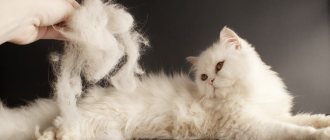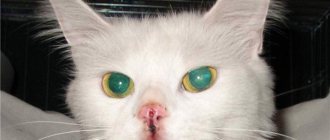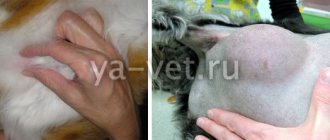If blackness appears in the ears of cats, this indicates poor ear hygiene or is a symptom of ear mites. With otodectosis, the disease has several stages of progression and is accompanied by severe itching, the appearance of crusts, and brown-black discharge. When a cat's ears turn black, the owner should take the pet to a veterinarian, who will diagnose and prescribe treatment.
According to veterinarians, ear parasites affect young cats and kittens whose immune systems are weakened.
Why does plaque appear?
Lack of hygiene
Earwax in cats, like in humans, has a protective function against the entry of pathogenic fungi, bacteria and small insects into the ear canal. It also serves as a lubricant for the inner canals of the ear. The auricle itself secretes a small amount of sebum. If a lot of wax and fat accumulate in the ears, dirt and dust stick to them. Because of this, a black coating is formed, especially noticeable in breeds with large ears and open ears - American Curl, Sphynx, Rex, Havanese, Javanese, Siamese, Oriental Shorthair cats.
Ear mite
This parasite can live in various animals.
The causative agent of otodectosis is the microscopic oribatid mite Otodectes. It parasitizes not only cats, but also dogs, rodents, and ferrets. Therefore, infection of a domestic cat is possible from other pets visiting the street. A sick cat can also infect all the pets living in the room with it. Most often it develops in animals with weak immunity and lack of hygiene. The parasite is very rare in humans and causes otitis externa.
The cat has black plaque in his ears. Where to go?
- Ace Ventura. Laboratory diagnostics for ectoparasites (otodectosis, etc.) 400 rubles. You can call a doctor at home. The cost depends on the distance from the clinic and varies from 1,000 to 10,000 rubles. Address: Academician Vinogradova street, 1k1, 1st floor.
- Aura Clinic. Analysis for otodectosis 200 rubles. Initial appointment 650 rubles. Address: Verkhnie Polya street, 36k1.
- Vega Clinic. Microscopy of ear contents for otodectosis 340 rubles. Appointment with a dermatologist is 1,500 rubles, a therapist is 765 rubles. Address: Marshal Katukova Street, 17k1, 2nd floor.
- Felis Veterinary Clinic. Taking scrapings for the presence of pathogenic fungi and mites (demodex, otodectosis) without the cost of examination (with materials) 200 rubles. Initial appointment is 400 rubles. Address: Udarnikov Avenue, 38 building 1, 1st floor.
- Center for Veterinary Diagnostics and Minimally Invasive Surgery TrustVet. Microscopy of skin scrapings, earwax to detect subcutaneous mites of the genera Sarcoptes, Notoedres, Demodex, Otodectes 600 rub. Appointment with a therapist costs 800 rubles. Address: Komendantsky Prospekt, 27 k1, ground floor.
When to sound the alarm?
If black spots and spots in a cat's ears are caused by poor hygiene, the animal remains calm and playful, and has a good appetite. The ear itself is white, not inflamed. Anxiety is caused by brown discharge, which is a waste product of the tick. Dangerous symptoms at different stages are shown in the table:
| Stage | Symptoms |
| Initial | The mite penetrates under the skin, irritating the nerve endings |
| The ear is very itchy and painful | |
| Redness and swelling of the external auditory canal | |
| Brown plaque in the ears that resembles asphalt | |
| Unpleasant smell | |
| Average | Dark crusts form and plugs form |
| Severe itching, the cat shakes its head and screams | |
| The appearance of scratches and wounds | |
| The auricle is lowered, the animal’s head is leaning towards the side of the affected ear | |
| Anxiety, aggression, poor sleep and appetite | |
| The mite spreads to the natural bald patches near the ear and muzzle, causing it to swell | |
| Perforation of the eardrum and introduction of mites into the inner ear | |
| Heavy | Dark plaque is visible not only inside the organ, but also on the tips of the ears |
| Parasites invade the brain, causing inflammation | |
| Sick animals meow loudly in pain | |
| Refusal to eat, apathy, seizures | |
| Possible death |
These crusts consist of a large number of small grains
If the auricle is damaged by a mite, it is necessary to systematically clean the ears. Using a cotton swab dipped in ear cleaner, carefully remove all crusts, mites and their deposits.
After this procedure, the surface of the ear should become clean. Next, special ear drops must be instilled into the ear. This is done in order to expel parasites from the deeper part of the ear. After administering the medicine, it is better to massage the ear for a few seconds so that the medicine reaches its target and is evenly distributed over the surface.
It often happens that several cats live in an apartment. In this case, in order to prevent infection with ear mites, all pets need to have their ears cleaned. These hygiene procedures should be observed not only if the animal is walking on the street, but even if the animal does not visit the street. After all, the owner can bring parasites from the street, for example, on shoes.
2. Another cause of itchy ears can be the sarcopid mite. What distinguishes it from an ordinary tick is that it affects not only the auricle, but also the nose and eyes. If treatment is not started on time, the mite can spread throughout the body and thereby cause a disorder of the nervous system. Symptoms include dry skin, cracks and bleeding wounds. To treat this disease, an integrated approach is required, increasing immunity and, possibly, prescribing antibiotics in case of suppuration of wounds.
3. Another reason is suppuration of wounds - abscess. This disease can develop when an infection enters a wound or scratch. This often happens if, for example, a cat in the country got into a fight with another representative of its species. An abscess is a swelling filled with pus. In this case, a visit to the veterinarian is simply necessary. The doctor will open the inflammation, remove the pus, treat it with anti-inflammatory drugs, and fill the wound with ointment. Subsequently, the owners will have to make sure that the pet does not scratch it; a special collar can help with this.
4. Otitis media or inflammation of the middle ear occurs not only in humans, but also in animals. A variety of untreated diseases can lead to inflammation:
· infections;
· injuries;
hypothermia or water getting into the ear canal;
· ear mite;
any foreign body in the ear canal.
Treatment of otitis should be carried out as prescribed by a veterinarian. For otitis media, antibiotics are prescribed. In severe cases, surgery may be necessary to drain fluid from the inner ear.
5. Various dermatitis can also lead to itchy ears in kittens. For an accurate diagnosis and selection of treatment, it will be necessary to take a scraping from the surface of the skin. Dermatoses affect not only the surface of the ear, but can also spread to all skin integuments, and hair loss is possible.
6. The most harmless of all reasons is a hematoma. Hematoma may occur
as a result of any trauma to the ear. The ear becomes red or blue and there is swelling. In this case, you can apply a cold compress
and a bandage. There are also ointments for bruises that help speed up the process of resorption of hematomas. However, in severe cases of hematoma, treatment is carried out by a veterinarian.
7. Itching can be caused by allergies. To determine allergens, tests are taken, subsequently a diet is prescribed, and recommendations are given based on the test results.
In this article, we looked at the main reasons why a kitten scratches its ears. We must remember that regular hygiene procedures will prevent the development of a large number of diseases. Proper treatment of an existing disease will eliminate the occurrence of complications. Be attentive to your pets.
Useful links:
Diagnostic measures
The animal's hearing organs are subject to a thorough examination by a doctor.
To find out why the ear turns black, the veterinarian performs an external examination. A specific crust, scratching and greasy black discharge help in making a diagnosis. To confirm otodectosis, plaque scraping and examination under a microscope are performed. The procedure takes little time, is painless and non-traumatic. An otoscopy is also performed to find out how much the inner ear is affected.
Algorithm of actions during treatment procedures
When adopting a pet, first consult your veterinarian on how to clean your kitten's ear when it gets dirty. There is a certain sequence of actions, following which you can carry out the hygiene procedure without any problems. To clean a kitten's ears, you need to do the following:
lay it on the table and press it a little against the tabletop; pull the ear over the edge with your thumb to inspect the inside; pay attention to the condition of the auditory canal - is there any redness or discharge there; if internal contamination is detected, carefully remove the dirt with a cotton swab treated with hydrogen peroxide; gently pull the edge of the auricle to open the ear canal; then you should pour in the required number of drops of the drug prescribed by the veterinarian for treatment; Without letting go of the kitten, lightly massage the base of the ear so that the healing liquid is distributed evenly; carefully clean the ear canal with a cotton swab; thoroughly blot the inside of the ear with a cotton pad; At the end of the procedure, reward the kitten for its patience with some of its favorite treats.
How to treat?
Veterinarians recommend cleaning your pet’s ears no more than 1-2 times a week, since daily hygiene procedures reduce the natural balance of beneficial microflora and make the cat vulnerable to pathogens.
If your cat’s ears have brown plaque and spots due to dirt, you should clean the outer part of the hearing organ with special hygiene products:
The hygiene of the external part of the pet's hearing organs can be maintained with the help of Otifri.
- "Leopard";
- "Otifri";
- "SkinMed Otik";
- "Tropiclean Dual";
- "Sani Pet";
- "Beafar Air Cleaner";
- "Trixie."
If your ears itch and hurt due to mites, you should treat them with anti-mite medications. The dosage for an adult cat and kitten is determined by a veterinarian; self-medication is prohibited. Both hearing organs should be instilled, even if infection occurs in only one. The procedure should be done with drugs such as “Bars”, “Otoferonol Gold”, “Amitrazine Plus”, “Surolan”. During the treatment period, all animals living in the premises, their sleeping places and accessories should be disinfected.
Treatment options
Effective medicines to combat ear mites are insecticide-based products. The only point that needs to be taken into account is that they act specifically on living parasites, but are absolutely not effective in killing larvae. Since the incubation period of infection is 21 days, the course of therapy should last at least three weeks, covering the entire life cycle of the tick.
Drops. Most often, the following drugs are prescribed: Tresaderm, Ivomek, Bars, Amitrazine Plus, Otoferonol Gold, Tsipam. The advantage of using Tresaderm is that the antibiotic included in its composition affects not only the adult tick, but also its eggs, and at the same time fights fungi and other infectious inflammations. The drug Ivomec can be prescribed in the form of injections and injected into the animal according to a schedule several times a month. The remaining drops from the above list tend to affect worms if they are present.
Important: so that the cat does not get nervous during instillation, the liquid must be slightly warmed up. Ointments (aerosols)
Aversectin ointment works well in practice, which is applied to the ear with a special spatula and is well absorbed into the skin during rubbing. Amit ointment, made on the basis of amitraz and prednisolone, has a similar acaricidal effect. Disinfection of the ears is carried out twice a day for 5 days. A cotton swab is lubricated with a creamy substance and then gently rubbed into the skin. Acaromectin spray, sprayed onto the inner surface of the ear according to the attached instructions, is effective against otodectosis.
Ointments (aerosols). Aversectin ointment works well in practice, which is applied to the ear with a special spatula and is well absorbed into the skin during rubbing. Amit ointment, made on the basis of amitraz and prednisolone, has a similar acaricidal effect. Disinfection of the ears is carried out twice a day for 5 days. A cotton swab is lubricated with a creamy substance and then gently rubbed into the skin. Acaromectin spray, sprayed onto the inner surface of the ear according to the attached instructions, is effective against otodectosis.
A doctor may also prescribe Stronghold, Frontline or Oridermil, but these drugs are contraindicated for use as self-medication - only on the recommendation of a veterinarian. For preventive purposes, the drug Revolution for Cats is often prescribed - It is applied to the withers using a drop method. After absorption into the skin, the active substance acts simultaneously on both ticks and fleas, if any.
Causes of hematoma formation on the oral mucosa
The general scheme of hematoma formation is as follows: a rupture of a vessel causes the leakage of a certain amount of blood, followed by its compaction and the appearance of a blood clot. A bubble forms, noticeable on the smooth surface of the mucosa due to its dark coloring and relief. Often a similar picture can be observed during teething, when the gums bleed and become inflamed. The formation of multiple small hematomas, covering the entire surface of the mucous membrane in the mouth with unattractive dark spots, looks very unpleasant for the patient. But don’t panic if you suspect you have a serious illness. As practice shows, most of these phenomena occur due to mechanical trauma to the mucous membrane. But there are exceptions when the symptom indicates:
- allergic reaction;
- chronic injury;
- consequences of stressful situations;
- burns or cuts to the mucous membrane.
There have also been cases when multiple hematomas in the oral cavity are signs of:
- diabetes mellitus;
- hypertension;
- renal failure;
- complex types of stomatitis;
- blood diseases;
- vitamin deficiency, which causes fragility of blood vessels.
The exact cause and stage of formation of the pathology can only be determined after a thorough examination and diagnosis. For this reason, you should not self-medicate, so as not to further injure damaged tissues.
Folk remedies
If for some objective reason a visit to the doctor is temporarily impossible, then traditional medicine comes to the rescue. Herbs and lotions are unlikely to be able to completely cure otodectosis, but they may well be able to alleviate the animal’s suffering until the time of visiting the veterinary clinic.
- Green tea based drops. A tablespoon of dry leaves is poured into a glass of water and left for 5-10 minutes. After cooling to a warm state, the solution is taken into a pipette and a few drops are instilled into each ear.
- Garlic has powerful antiseptic properties. In the case of ear mites, it is infused in oil for 24 hours, and then the resulting solution is instilled into the ears once a day. Olive, flaxseed, sunflower, almond and other oils are used as the basis for the tincture.
- Celandine juice is instilled into the ears in the morning and evening, two drops per ear. Freshly picked herbs are ground in a meat grinder and then squeezed in gauze to prevent any remaining leaves or stems from getting into the juice ready for use.
Types of otitis
The following types of otitis are distinguished:
- External.
- Medial.
- Interior.
Otitis externa
In addition to the presence of brown dirt, additional symptoms are observed:
- The cat shakes its head.
- The ears smell bad.
- Scratching, ulcers.
This type of disease responds well to treatment. The sluggishness of the fellinologist leads to the spread of pathology to the underlying parts of the organ. Inflammation of the middle ear occurs.
Medial otitis media
It develops most often in the absence of treatment or an incorrect diagnosis. The disease becomes permanent. There is a squelching sound in the ear, excruciating pain occurs for the cat, and a stench spreads. Exudate is constantly released. The cat loses its appetite, the temperature rises, and the animal does not allow it to touch its hearing organs. The ear is designed in such a way that it is impossible to see the source of inflammation without a special device, so it is impossible to do without qualified help.
The pathology is characterized by seasonal exacerbations occurring in autumn and spring. Otitis media predisposes to the development of malignant tumors. During treatment, drugs with antiphlogistic, analgesic, and antimicrobial effects are used. Most often, lifelong therapy is required.
Internal otitis
Inflammation of the labyrinth is the most dangerous type of hearing organ pathology. The likelihood of deafness and the spread of inflammation to the cerebrum increases.
Unskilled treatment transforms an acute disease into a permanent one, aggravates the disease, and makes further treatment difficult. The best solution if you suspect otitis media is to seek veterinary help.
Characteristic symptoms
The animal cannot say in words what exactly is bothering it, so it expresses its discomfort through various behavioral actions. In the case of ticks, these will be the following symptoms:
- The cat begins to behave very restlessly, constantly jerking its head, as if trying to shake off parasites.
- He tries to get into the ear canal with his paws, gets nervous when he can’t penetrate deeper, and scratches his ears until they bleed.
- In a desire to get rid of constant itching, the cat looks for hard, stable pieces of furniture to rub its head on, or “sticks” to door frames, corners and steps.
- Dark brown and brown liquid oozes from the combed ears. An unpleasant odor appears. The pile in the lower area of the ear tassels sticks together.
- Partial or complete loss of hearing is observed.
- Body temperature rises slightly.
Important: in order not to blur the clinical picture, it is not advisable to carry out any hygiene procedures before visiting the veterinarian. You should also refrain from instilling drops or applying any ointments.
Additional measures to prevent hematomas
To reduce the risk of blood balloons swelling on the oral mucosa, patients are advised to follow a few simple rules:
- avoid salty and spicy foods that irritate the mucous membranes;
- adjust the design of prostheses and orthopedic systems for the jaw apparatus;
- increase the amount of medium-temperature liquid and semi-liquid foods in the diet
We should also not forget about the need to regularly visit the dentist for the timely detection and elimination of diseases of the teeth and gums. This solution will help maintain oral health and avoid a number of serious pathologies with unpleasant symptoms.











